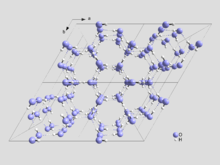Molecular Simulation/Hydrogen Bonds
Hydrogen bonding is a type polar binding between a hydrogen atom that is bound to another atom with a large electronegativity, these then form electrostatic interactions with a hydrogen bond acceptor. Hydrogen bond acceptors fall into two main categories: atoms with a large negative charge such as Cl- or Br- and another compound with a polar bond, such as a ketone or carboxylic acid. These bonds are a subclass of dipole-dipole interactions. These interactions are found in many different scenarios, they are present in some organic solvents, solid crystal structures, proteins and DNA.
Hydrogen Bonding in Liquids
[edit | edit source]Hydrogen bonds are present in organic liquids like water, ethanol, hydrogen fluoride, and N-methylacetamide. These hydrogen bonds are partially responsible for the large enthalpies of vaporization, along with higher boiling points than hydrocarbons with comparable sizes. For example, the boiling point of hexane is 68 °C but the boiling point is hexanol is 135 °C. This is due to the hydrogen bonds that can be formed between the hydrogen atoms on the alcohols interacting with the oxygen atoms on other hexanol molecules.

Hydrogen Bonding in Solids
[edit | edit source]
Hydrogen bonds are also present in solids. The bonding in the solids is observed to allow for maximum packing of molecules that will give the solid the maximum number of hydrogen bonds leading to a stronger crystal. This can be observed in solid water, and is responsible for some of waters unique properties. Each water molecule is capable of donating two hydrogen bonds and accepting two hydrogen bonds.
Strength of Interactions
[edit | edit source]Magnitudes of hydrogen bonds are dependent on a couple different factors, the first is the difference in electronegativity of the atom that hydrogen is attached. The larger the difference in electronegativity the stronger the interaction will be. The second being the radius of the acceptor, it needs to be of a size that will allow for the hydrogen to get close enough to interact. Generally the Slater radius should be between 0.65 – 1.00 Å, any larger than this will not allow for the hydrogen to become close enough to the atom to attractively interact. The figure on the right illustrates the potential energies of the dimerization of HF and CH3Cl, They both have very similar dipole moments, and but due to the hydrogen bonding the interactions between the HF molecules a larger potential energy minimum can be obtained, illustrated by the larger well depth. Also in this figure the well appears at a lower radius for the HF, and this is due to the previously mentioned dependence on the radius of the acceptor, the F is smaller than the Cl allowing for the hydrogen to get closer for stronger interactions. The directionality of the hydrogen bond also has effects on the strength of the bond, the optimal angle of interaction is 180°, while the optimal distance for interaction is between 1.5 – 2.5 Å. Planar molecules can contain very strong hydrogen bonding capabilities. The molecule being flat allows for constructive bond dipoles and it avoids steric clashes between other atoms in the molecule.
Dependence on Distance
[edit | edit source]The strength of hydrogen bonds dissipate rather quickly, they follow the same exponential trend that dipole dipole interactions follow, which is illustrated by the equation below:
Dipole-Dipole Interactions
Where θ1 , θ2 and Φ are the two angles of orientation and the dihedral angles respectively. This equation illustrates that there is an inverse relationship between the strength of the bond and the distance between the dipoles cubed.
Effect of Radius

